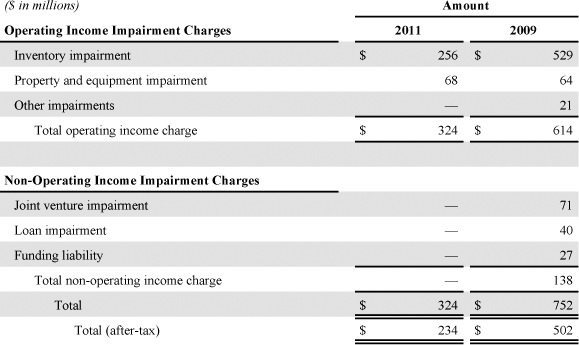MD&A
Quantitative and Qualitative Disclosures About Market Risk
Financial Statements
Notes to Financial Statements
Shareholder Return Performance Graph
Quarterly Financial Data
Selected Historical Financial Data
Non-GAAP Financial Measure Reconciliation
Management’s Reports
Reports of Independent Registered Public Accounting Firm
18. TIMESHARE STRATEGY-IMPAIRMENT CHARGES
2011 Charges
Prior to the spin-off of our Timeshare segment, management assessed the Timeshare segment’s intended use of excess undeveloped land and built inventory and the then current market conditions for those assets. On September 8, 2011, management approved a plan for the Timeshare segment to accelerate cash flow through the monetization of certain excess undeveloped land in the U.S., Mexico, and the Bahamas over the next 18 to 24 months and to accelerate sales of excess built luxury fractional and residential inventory over the next three years. As a result, in accordance with the guidance for accounting for the impairment or disposal of long-lived assets, because the nominal cash flows from the planned land sales and the estimated fair values of the land and excess built luxury inventory were less than their respective carrying values, we recorded a pre-tax non-cash impairment charge of $324 million ($234 million after-tax) in the 2011 third quarter under the “Timeshare strategy-impairment charges” caption of our Income Statement.
We estimated the fair value of the land by using recent comparable sales data for the land parcels, which we determined were Level 3 inputs. We estimated the fair value of the excess built luxury fractional and residential inventory using cash flow projections discounted at risk premiums commensurate with the market conditions of the related projects. We used Level 3 inputs for these discounted cash flow analyses and our assumptions included: growth rate and sales pace projections, additional sales incentives such as pricing discounts, and marketing and sales cost estimates.
2009 Charges
In response to the difficult business conditions that the Timeshare segment’s timeshare, luxury residential, and luxury fractional real estate development businesses experienced, we evaluated our entire Timeshare portfolio in the 2009 third quarter. In order to adjust the business strategy to reflect current market conditions at that time, we approved plans for our Timeshare segment to take the following actions: (1) for our luxury residential projects, reduce prices, convert certain proposed projects to other uses, sell some undeveloped land, and not pursue further Marriott-funded residential development projects; (2) reduce prices for existing luxury fractional units; (3) continue short-term promotions for our U.S. timeshare business and defer the introduction of new projects and development phases; and (4) for our European timeshare and fractional resorts, continue promotional pricing and marketing incentives and not pursue further development. We designed these plans, which primarily related to luxury residential and fractional resorts, to stimulate sales, accelerate cash flow, and reduce investment spending.
Composition of 2011 and 2009 Charges and Other Information
As a result of the actions (described in preceding paragraphs) in 2011 and 2009, we recorded the charges shown in the following table in our Income Statements, with charges that impacted operating income under the “Timeshare strategy-impairment charges” caption and charges that impacted non-operating income under the “Timeshare strategy-impairment charges (non-operating)” caption:

Grouped by product type and/or geographic location, the 2011 impairment charges consisted of $203 million associated with undeveloped land parcels in North America associated with five timeshare properties, $113 million associated with nine North American luxury fractional and mixed use properties, $2 million related to one project in our European timeshare business, and $6 million of software previously under development that would not be completed and used under the new strategy. The 2009 impairment charges consisted of $295 million associated with five luxury residential projects, $299 million associated with nine North American luxury fractional projects, $93 million related to one North American timeshare project, $51 million related to the four projects in our European timeshare and fractional business, and $14 million associated with two Asia Pacific timeshare resorts.
Additionally, upon the approval of the plan in 2011 to dispose of certain undeveloped land parcels, we reclassified $57 million of these land parcels previously in our development plans from inventory to property and equipment. We also reviewed the remainder of our 2011 Timeshare segment inventory assets prior to the spin-off date and determined that there were no other adjustments needed to their carrying values.
Both the 2011 and 2009 impairment charges were non-cash, other than the following 2009 charges: $27 million of charges associated with then projected mezzanine loan fundings and $21 million of charges for purchase commitments. Except for the $40 million loan impairment and the $27 million funding liability recorded in 2009, we allocated the remaining 2009 pretax charges totaling $685 million and the 2011 pretax charges totaling $324 million to our Timeshare segment.
For additional information on the 2009 impairment charges, including how we determined these impairments and the inputs we used in calculating fair value, please see Footnote No. 20, “Timeshare Strategy-Impairment Charges,” in the Notes to the Financial Statements of our 2009 Form 10-K.
In 2011 and 2010, we reversed (based on facts and circumstances surrounding the project, including progress on certain construction-related legal claims and potential funding of certain costs by one of our partners) $3 million and $11 million, respectively, of the $27 million funding liability we originally recorded in 2009. We recorded the reversals of the funding liability in the equity in (losses) earnings line in our Income Statements, but did not allocate it to any of our segments. We transferred the remaining balance of the funding liability on the spin-off date to MVW as part of the spin-off.
